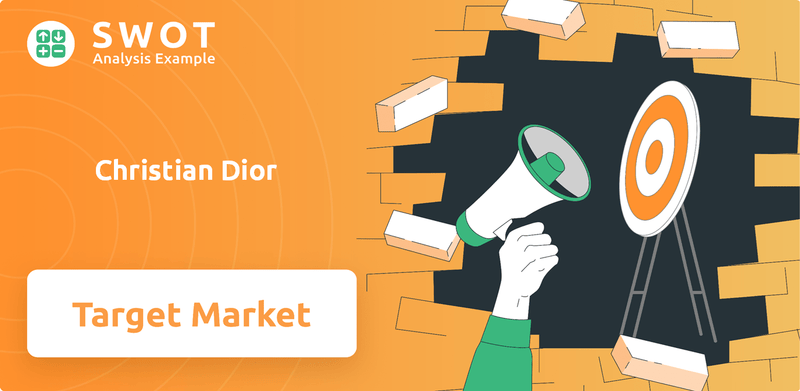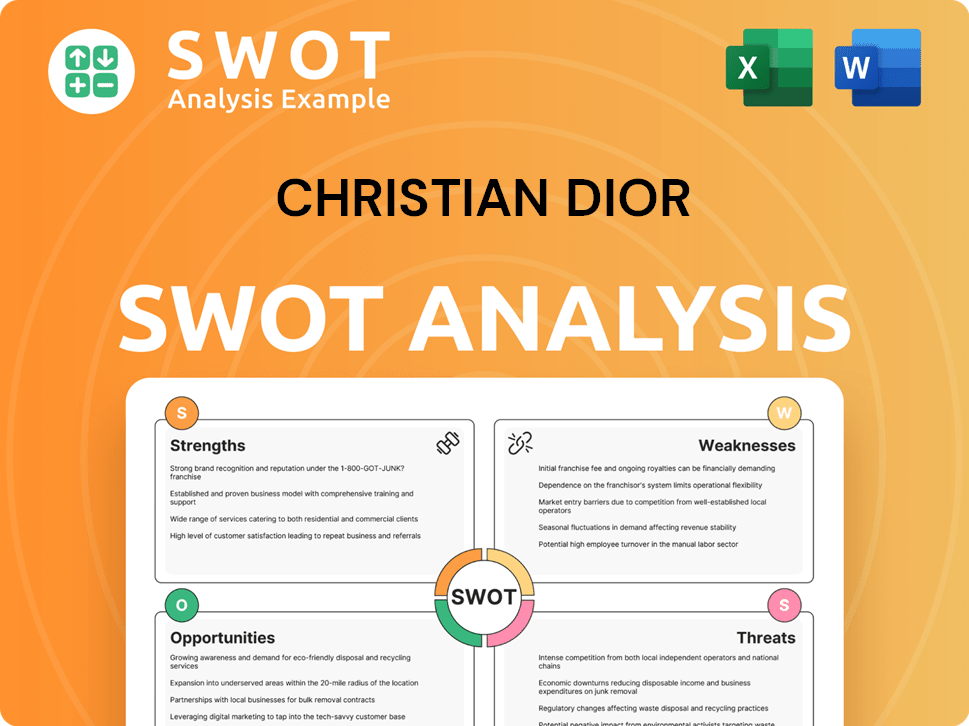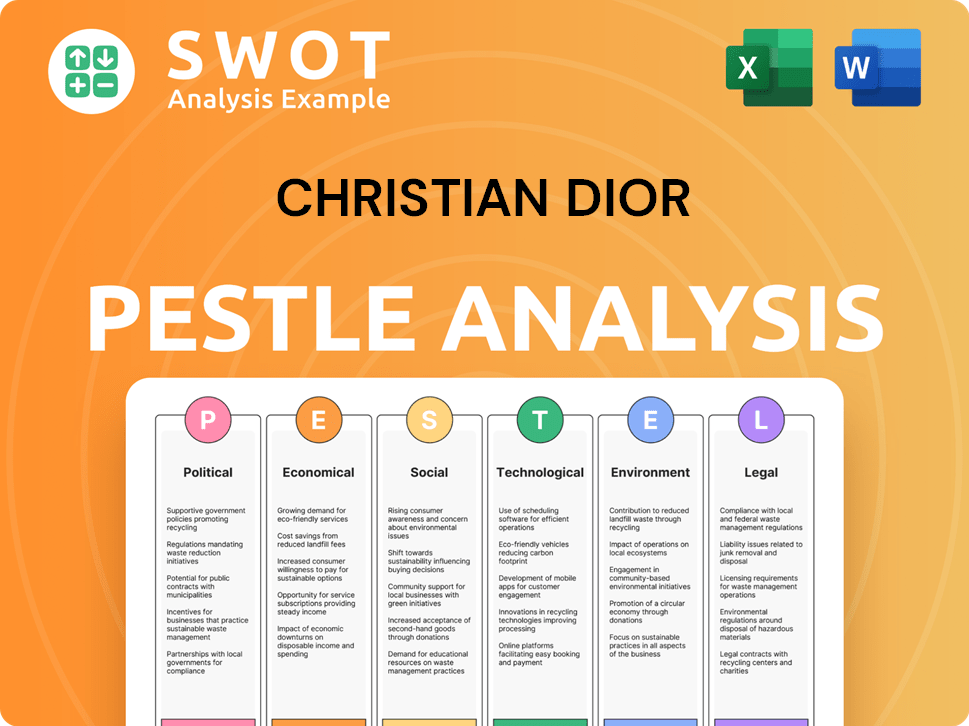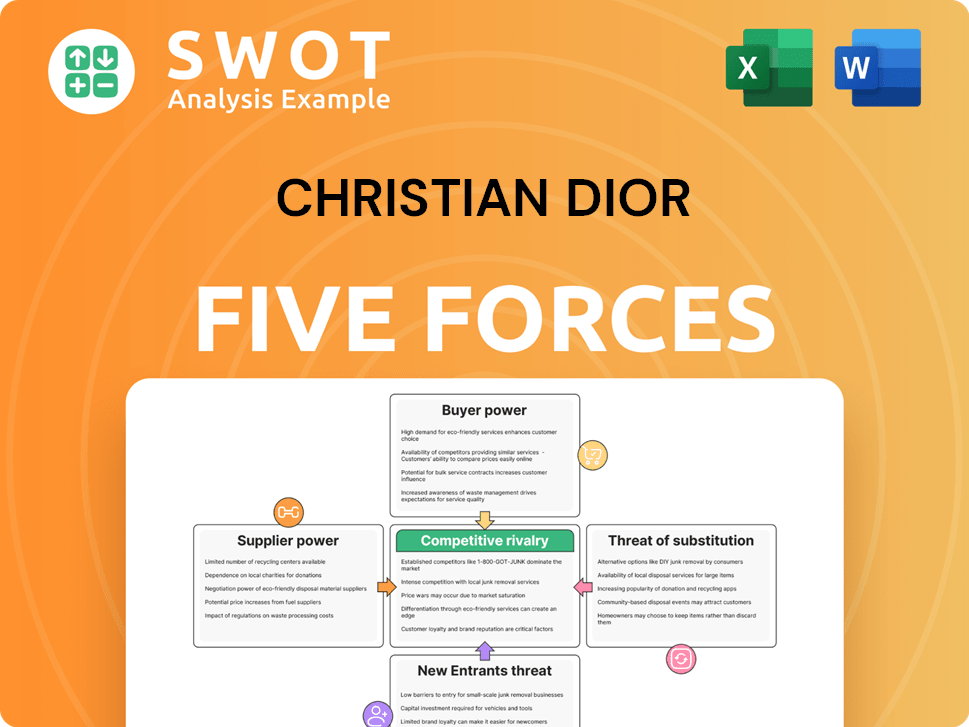Christian Dior Bundle
Who Buys Christian Dior?
Christian Dior, a name synonymous with luxury, has captivated the fashion world since 1946. But who are the individuals fueling this iconic brand's success? Understanding the Christian Dior SWOT Analysis is crucial to grasp the brand's evolution and its strategic shifts in targeting its customer base. This exploration delves into the core of Dior's identity: its customers.

From haute couture to a vast array of luxury goods, Dior's customer profile has dramatically broadened. This analysis will dissect the Christian Dior demographics and Dior target market, revealing the brand's ability to cater to diverse consumer segments. We'll examine Dior customer profile across geographic, demographic, and psychographic dimensions, providing a comprehensive view of the luxury fashion consumers driving Dior's global presence and its success among high-end fashion brands.
Who Are Christian Dior’s Main Customers?
Understanding the Christian Dior demographics and Dior target market is crucial for appreciating its success in the luxury fashion industry. The brand caters to a diverse clientele, each segment with unique characteristics and purchasing behaviors. This analysis explores the primary customer segments, their profiles, and how the brand adapts to evolving market trends.
The Dior customer profile varies across its product lines, from haute couture to beauty products. This segmentation allows the brand to effectively target different consumer groups with tailored marketing strategies and product offerings. Let's delve into the specifics of these key customer segments.
The core customer base for Christian Dior includes ultra-high-net-worth individuals, primarily women aged 35-65+, who are global, highly educated, and seek exclusivity. The brand also targets affluent consumers aged 25-55, with high-middle to high-income levels, for its ready-to-wear, leather goods, and accessories. The beauty segment expands to include younger consumers aged 18-35, who aspire to luxury.
This segment primarily targets ultra-high-net-worth individuals. The key demographic is women aged 35-65+, holding executive or influential positions. These customers value exclusivity, craftsmanship, and status. They are globally distributed, reflecting the brand's international presence.
The target audience broadens to include affluent consumers. This segment includes both men and women, typically aged 25-55. They have high-middle to high-income levels and appreciate brand heritage, quality, and contemporary luxury.
This segment targets a broader demographic, including younger consumers. The age range is typically 18-35, with varying income levels. These consumers aspire to luxury and seek accessible entry points into the brand.
The business-to-consumer (B2C) model is dominant across all segments. This approach allows Dior to directly engage with its customers. Dior uses various channels, including retail stores, e-commerce, and social media, to reach its target audience.
Christian Dior has strategically adapted to a younger, digitally-native demographic. This shift is evident in marketing campaigns featuring younger ambassadors and increased digital engagement. The rise of e-commerce and social media has significantly influenced this evolution.
- Digital Engagement: Dior has increased its presence on social media platforms.
- E-commerce Growth: Online sales have become a significant part of the brand's revenue.
- Younger Ambassadors: The brand uses younger celebrities and influencers.
- Market Trends: Dior adapts to the changing preferences of luxury fashion consumers.
Christian Dior SWOT Analysis
- Complete SWOT Breakdown
- Fully Customizable
- Editable in Excel & Word
- Professional Formatting
- Investor-Ready Format

What Do Christian Dior’s Customers Want?
Understanding the customer needs and preferences is crucial for the success of any luxury brand, and Christian Dior is no exception. The brand's customer base is diverse, but they share a common appreciation for quality, exclusivity, and the aspirational lifestyle associated with the brand. This chapter explores the key drivers behind customer purchasing behavior, usage patterns, loyalty factors, and how Dior adapts to evolving market trends.
The primary motivations for purchasing Dior products include self-expression, a connection to artistry, and the prestige associated with the brand. Customers are drawn to Dior's heritage, artistic direction, and the emotional connection these elements create. Dior caters to these desires through meticulously crafted products, personalized services, and marketing that showcases diverse lifestyles.
Dior's approach to meeting customer needs and preferences is multifaceted, encompassing product design, marketing, and customer service. They focus on creating a unique brand experience that resonates with their target audience. For a deeper look into the brand's origins, you can read about the Brief History of Christian Dior.
Customers are driven by a desire for self-expression and the prestige associated with the brand. They seek unique designs, unparalleled craftsmanship, and personalized service. The brand's heritage and artistic direction also play a significant role in attracting customers.
Haute couture pieces are typically reserved for special occasions, while ready-to-wear and accessories are integrated into daily luxury lifestyles. The usage varies, but the common thread is the integration of Dior products into a sophisticated lifestyle. Accessories often serve as an entry point to the brand.
Loyalty stems from consistent brand experience, product excellence, and the emotional resonance of owning a Dior piece. Customers are drawn to the brand's ability to maintain its image and quality over time. The brand's exclusivity also fosters loyalty.
Dior addresses the need for exclusivity through limited editions and bespoke services, and the desire for quality through meticulous attention to detail and premium materials. This approach reinforces the brand's premium positioning. Bespoke services cater to individual preferences.
The growing demand for sustainability and ethical practices has influenced product development, with Dior incorporating more environmentally conscious materials and processes. Marketing showcases diverse individuals and lifestyles. Dior adapts to evolving consumer preferences.
Marketing showcases diverse individuals and lifestyles, while product features often include innovative designs and collaborations with artists. This caters to the evolving aesthetic preferences of its diverse customer base. Collaborations keep the brand fresh.
The Dior customer profile is diverse, but generally includes individuals with a high disposable income, a strong interest in fashion, and an appreciation for luxury. The brand's marketing strategy targets a broad audience, from affluent millennials to established luxury consumers. Dior's customer base is global, with significant markets in Asia, Europe, and North America. Dior's ability to maintain its brand image and adapt to changing consumer preferences is key to its success.
- Customer Age Range: Spans a wide range, from young adults (25-34) to older demographics (45+), with marketing tailored to different age groups.
- Income Levels: Primarily targets high-net-worth individuals and those with significant disposable income, with products ranging in price to cater to different segments.
- Geographic Market Analysis: Strong presence in major cities globally, with flagship stores and boutiques in key fashion capitals and high-traffic tourist destinations.
- Customer Buying Habits: Purchases are often driven by a combination of impulse and planned acquisitions, with seasonal collections and limited editions creating a sense of urgency.
- Customer Brand Loyalty: High levels of brand loyalty, driven by the brand's heritage, quality, and exclusive experiences.
Christian Dior PESTLE Analysis
- Covers All 6 PESTLE Categories
- No Research Needed – Save Hours of Work
- Built by Experts, Trusted by Consultants
- Instant Download, Ready to Use
- 100% Editable, Fully Customizable

Where does Christian Dior operate?
Christian Dior maintains a significant global presence, focusing on key regions such as Europe, Asia, and North America. These areas are crucial for the brand's market share and recognition. The company strategically targets countries like France, Italy, the United Kingdom, the United States, China, Japan, and South Korea, adapting its approach to suit local preferences and buying behaviors.
The brand customizes its strategies to resonate with the diverse tastes of its customer base. For example, Asian markets often favor new collections and limited editions, while European customers may lean towards classic designs. North American consumers typically seek a blend of both classic and contemporary styles. This tailored approach is vital for maintaining Dior's strong position in the luxury fashion market.
To succeed in these varied markets, Christian Dior localizes its offerings and marketing efforts. This includes adapting product assortments, marketing campaigns, and forming local partnerships. Recent expansions have targeted emerging luxury markets, particularly in Southeast Asia and the Middle East, to capitalize on new growth opportunities. Understanding the Competitors Landscape of Christian Dior is also key to evaluating its market position.
Dior's main markets include Europe, Asia, and North America. These regions are crucial for the brand's sales and growth.
Major markets include France, Italy, the United Kingdom, the United States, China, Japan, and South Korea. These countries represent significant market share and brand recognition for Dior.
Asian markets often prefer new collections and limited editions, while European customers may favor heritage designs. North American consumers seek a mix of classic and contemporary styles.
Dior customizes product assortments, marketing campaigns, and partnerships to suit regional tastes. This approach helps the brand maintain its strong position in the luxury fashion market.
Asia (excluding Japan) consistently represents a dominant region in sales for LVMH, Dior's parent company. This highlights the importance of this market to Dior's overall sales and growth.
Europe is another significant market for Dior, contributing substantially to the brand's global revenue. Understanding the customer preferences in this region is critical.
The United States is a key market, offering a blend of classic and contemporary styles. Dior's ability to cater to this diverse market is a strength.
Dior is focusing on emerging luxury markets in Southeast Asia and the Middle East to capture new growth opportunities. This expansion strategy is essential.
The geographic distribution of sales for LVMH shows Asia (excluding Japan) as a dominant region, followed by Europe and the United States. This distribution underscores Dior's strategic focus.
Dior tailors its marketing campaigns to cultural nuances, engaging in local partnerships to resonate with diverse customer bases. This approach enhances brand relevance.
Christian Dior Business Model Canvas
- Complete 9-Block Business Model Canvas
- Effortlessly Communicate Your Business Strategy
- Investor-Ready BMC Format
- 100% Editable and Customizable
- Clear and Structured Layout

How Does Christian Dior Win & Keep Customers?
Christian Dior, a powerhouse in the luxury fashion industry, employs a multifaceted approach to acquire and retain customers. Their strategies blend classic luxury marketing with innovative digital techniques. The goal is to maintain a strong brand image and cultivate lasting relationships with a discerning clientele. Understanding the Owners & Shareholders of Christian Dior is also crucial to understanding the brand's long-term strategies.
Customer acquisition focuses on creating aspirational experiences through high-profile events and targeted campaigns. Retention efforts prioritize personalized service and exclusive offerings to foster loyalty. This dual approach ensures that Dior not only attracts new customers but also cultivates a dedicated base of repeat buyers.
The brand's marketing channels are diverse, including fashion shows, print advertisements, and digital campaigns. These efforts are supported by influencer collaborations and exclusive in-store experiences, all designed to attract and engage the target market. Customer relationship management (CRM) systems play a crucial role in segmenting the clientele for personalized marketing.
Dior leverages its high-profile fashion shows and exclusive events to generate buzz and attract media attention. These events showcase the latest collections and create a sense of exclusivity. They are a key part of the brand's marketing strategy, attracting both new and existing customers.
Extensive digital campaigns across platforms like Instagram, TikTok, and WeChat are crucial. These campaigns are designed to reach a global audience, showcasing new products and brand initiatives. Digital marketing is a vital tool for engaging with the target market.
Collaborations with global celebrities and micro-influencers are key to reaching diverse audiences. These partnerships help increase brand visibility and credibility. Influencer marketing is a vital component of Dior's acquisition strategy.
Exclusive in-store experiences and personalized clienteling are central to the sales strategy. Private appointments and bespoke services provide a luxurious shopping experience. These efforts aim to build strong customer relationships.
Dior's retention strategies emphasize exclusivity, personalized service, and after-sales support. Loyalty programs, though often discreet, offer access to new collections and private events. The focus is on building long-term relationships and increasing customer lifetime value.
- Loyalty Programs: Exclusive access to new collections and private events.
- Personalized Services: Tailored styling advice and bespoke recommendations.
- After-Sales Service: Ensuring a seamless and luxurious experience.
- CRM Systems: Utilizing customer data for targeted campaigns and communications.
Christian Dior Porter's Five Forces Analysis
- Covers All 5 Competitive Forces in Detail
- Structured for Consultants, Students, and Founders
- 100% Editable in Microsoft Word & Excel
- Instant Digital Download – Use Immediately
- Compatible with Mac & PC – Fully Unlocked

Related Blogs
- What are Mission Vision & Core Values of Christian Dior Company?
- What is Competitive Landscape of Christian Dior Company?
- What is Growth Strategy and Future Prospects of Christian Dior Company?
- How Does Christian Dior Company Work?
- What is Sales and Marketing Strategy of Christian Dior Company?
- What is Brief History of Christian Dior Company?
- Who Owns Christian Dior Company?
Disclaimer
All information, articles, and product details provided on this website are for general informational and educational purposes only. We do not claim any ownership over, nor do we intend to infringe upon, any trademarks, copyrights, logos, brand names, or other intellectual property mentioned or depicted on this site. Such intellectual property remains the property of its respective owners, and any references here are made solely for identification or informational purposes, without implying any affiliation, endorsement, or partnership.
We make no representations or warranties, express or implied, regarding the accuracy, completeness, or suitability of any content or products presented. Nothing on this website should be construed as legal, tax, investment, financial, medical, or other professional advice. In addition, no part of this site—including articles or product references—constitutes a solicitation, recommendation, endorsement, advertisement, or offer to buy or sell any securities, franchises, or other financial instruments, particularly in jurisdictions where such activity would be unlawful.
All content is of a general nature and may not address the specific circumstances of any individual or entity. It is not a substitute for professional advice or services. Any actions you take based on the information provided here are strictly at your own risk. You accept full responsibility for any decisions or outcomes arising from your use of this website and agree to release us from any liability in connection with your use of, or reliance upon, the content or products found herein.